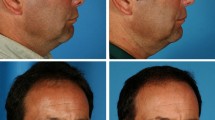Abstract
The extended spreader graft technique in septorhinoplasty is presented. The procedure involves applying spreader grafts before lateral osteotomies to support the whole osteocartilaginous vault. This study enrolled 51 patients who had undergone open septorhinoplasty between January 2010 and March 2012. The dorsal width ratio (DWR) was calculated for each patient by dividing the keystone width score by the intercanthal width score. The preoperative DWR scores classified 32 of the 51 noses as normal, six noses as narrow, and 13 noses as wide. All the patients with a nose classified as narrow preoperatively had a nose with a normal width postoperatively. All but one patient who had a normal preoperative DWR score also had a normal DWR score postoperatively. Of the 13 patients who had a wide nose preoperatively, seven were classified in the normal-width group postoperatively. Although the remaining six patients had a positive DWR score change (DWR closer to 0.50), they still were in the wide-nose group postoperatively. All but three patients were satisfied with their cosmetic and aesthetic results. Inverted-V or open-roof deformities were not observed. For all 18 patients in the normal nasal width group preoperatively (18/32), the nasal dorsum seemed wide after lateral osteotomies due to the spacing effect of the graft. As a result of medializing the bones, the caudal end of the graft became palpable. Although the graft position was checked perioperatively, at the postoperative 6-month follow-up assessment, three patients had palpable cartilages in the keystone area, one of which needed a surgical revision. Extended spreader grafts applied before lateral nasal osteotomies can support the entire nasal dorsum, including the bony vault. This spacing effect could be highly advantageous for both narrow and wide noses. In narrow noses, these grafts prevent further narrowing of the osteocartilaginous vault and support the dorsal aesthetic lines. In wide noses, extended spreader grafts fill the bone gap before lateral osteotomy and help to prevent open-roof deformity. In addition, fixing the upper lateral cartilages before lateral osteotomies might further prevent bone collapses, even after premature fractures. In normal-width noses, after completion of the lateral osteotomies, the bone gap usually does not persist, and nasal bones push the cranial end of the spreader graft dorsally. Therefore, in normal-width noses, extending the graft along the bony gap is not necessary, and the use of extended spreader grafts is not preferred.
Level of Evidence IV
This journal requires that authors assign a level of evidence to each article. For a full description of these Evidence-Based Medicine ratings, please refer to the Table of Contents or the online Instructions to Authors www.springer.com/00266.





Similar content being viewed by others
References
Acarturk S, Gencel E (2003) The spreader-splay graft combination: a treatment approach for the osseocartilaginous vault deformities following rhinoplasty. Aesthetic Plast Surg 27:275–280
Byrd HS, Meade RA, Gonyon DL (2007) Using the autospreader flap in primary rhinoplasty. Plast Reconstr Surg 119:1897–1902
Daniel RK (1993) The osseocartilaginous vault. In: Daniel RK (ed) Rhinoplasty. Little, Brown, Boston, pp 169–214
Gruber RP, Park E, Newman J et al (2007) The spreader flap in primary rhinoplasty. Plast Reconstr Surg 119:1903–1910
Gunter JP (1993) Secondary rhinoplasty: The open approach. In: Daniel RK (ed) Rhinoplasty. Brown Boston, Little, pp 833–847
Gurlek A, Celik M, Fariz A et al (2006) The use of high-density porous polyethylene as a custom-made nasal spreader graft. Aesthetic Plast Surg 30:34–41
Guyuron B, Michelow BJ, Englebardt C (1998) Upper lateral splay graft. Plast Reconstr Surg 102:2169–2177
Reyneke JP, Ferretti C (2012) Clinical assessment of the face. Semin Orthod 18(3):172–186
Nyte CP (2006) Spreader graft injection with calcium hydroxylapatite: a nonsurgical technique for internal nasal valve collapse. Laryngoscope 116:1291–1292
Oneal RM, Berkowitz RL (1998) Upper lateral cartilage spreader flaps in rhinoplasty. Aesth Surg J 18:370–371
Ozmen S, Ayhan S, Findikcioglu K, Kandal S, Atabay K (2008) Upper lateral cartilage fold-in flap: a combined spreader and/or splay graft effect without cartilage grafts. Ann Plast Surg 61:527–532
Ozmen S, Findikcioglu K, Kandal S et al (2006) Upper lateral cartilage fold-in flap: a combined spreader and/or splay graft effect without cartilage grafts. Plast Reconstr Surg Suppl 118:173–174
Reiffel AJ, Cross KJ, Spinelli HM (2011) Nasal spreader grafts: a comparison of Medpor to autologous tissue reconstruction. Ann Plast Surg 66:24–28
Rohrich RJ, Hollier LH (1996) Use of spreader grafts in the external approach to rhinoplasty. Clin Plast Surg 23:255–262
Rohrich RJ, Gunter JP, Deuber MA, Adams WP (2002) The deviated nose: optimizing results using a simplified classification and algorithmic approach. Plast Reconstr Surg 110:1509–1523
Seyhan A (1997) Method for middle vault reconstruction in primary rhinoplasty: upper lateral cartilage bending. Plast Reconstr Surg 100:1941–1943
Sheen JH (1984) Spreader graft: a method of reconstructing the roof of the middle nasal vault following rhinoplasty. Plast Reconstr Surg 73:230–239
Stal S, Hollier L (2000) The use of resorbable spacers for nasal spreader grafts. Plast Reconstr Surg 106:922–928
Author information
Authors and Affiliations
Corresponding author
Rights and permissions
About this article
Cite this article
Kucuker, I., Özmen, S. Extended Spreader Graft Placement Before Lateral Nasal Osteotomy. Aesth Plast Surg 37, 684–691 (2013). https://doi.org/10.1007/s00266-013-0168-3
Received:
Accepted:
Published:
Issue Date:
DOI: https://doi.org/10.1007/s00266-013-0168-3




